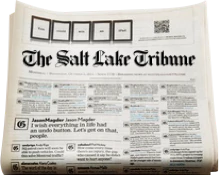This is an archived article that was published on sltrib.com in 2008, and information in the article may be outdated. It is provided only for personal research purposes and may not be reprinted.
In 2005, Erin Hogan, director of public affairs at the Art Institute of Chicago, set out in her Volkswagen for a monumental road trip. She aimed her steering wheel toward the American West's key land artworks, including two Utah sculptures - Robert Smithson's "Spiral Jetty" and Nancy Holt's "Sun Tunnels" - as well as Walter De Maria's "Lightning Field" in western New Mexico.
The result of her journey is the memoir Spiral Jetta (University of Chicago Press, $20), an irreverent, thoughtful exploration of the magic and often maddening intersection of solitude, art and landscape.
What motivated you to make the trip?
I was always the kind of person who was never alone. I would wake up at 6 in the morning and go for a run with two friends and then go to work and be with people all day and then after work go out with people for a drink. When I look back, I think my alone time was about a half an hour per day. But I always felt that there was some dimension to being human that's only accessible when you're alone. . . . I was 38, I didn't have children. And I hadn't fully explored the liberty I had constructed for myself.
Did you have an awareness of yourself taking an iconic American journey?
I definitely felt like I was involving myself in the Great American Road saga. Before I left, I re-read [Jack] Kerouac's On the Road, and as I was traveling I was really aware of the principles of manifest destiny and the Beats and all that. I wasn't thinking about Walden Pond or Thoreau.. . . I think Thoreau very consciously sat back and let things come to him. His point was about being still and noticing things and being attentive. My point was more Western - to get out there and be on the move. It was a more extroverted way of being an introvert. Unlike Thoreau, I felt the need to encounter things and people. At the same time, one of the greatest things I learned on the way is that the key to being able to be alone is to finally have other thoughts than "Jesus, I'm really alone out here."
And why seek out land art specifically?
Land art is this arena you walk into, and it changes your sense of space and time. The people who made it were trying to set up a different experience, giving us something. I wanted to experience that, a surprising built environment. But really, the book is mostly a road book. Yeah, I meditate on Michael Fried and the theatricality of landscape, but I'd like to think that someone who didn't study art history like I did would encounter something very beautiful in "Spiral Jetty." In my case, I had the most powerful experience at the "Lightning Field," just sheer physical and sensory overload because my mind didn't get into it at all. I think it's possible to think too much about things. Sometimes you can just let them happen.
One of the startling things for some readers is that you didn't bring along a compass with you and that there are some sites you missed altogether because you got lost.
I'm actually a very good navigator. I've just not spent a lot of time in places where there aren't roads. I don't know how to read a compass, and I've never used GPS, so I planned to rely on where the sun was to find direction. The only problem was, I was trying to find things between 11 [a.m.] and 1 [p.m.] when the sun wasn't giving me such a lot of help. I mean, I didn't see any art in lots of parts of the book.
As you were traveling, were you consciously composing a book?
I thought that I would maybe write an article or two, so I was very assiduous about keeping notes, and I had a cassette recorder with me. I thought maybe this could be something, but I wasn't sure what. Then later, when it did become a book, the audience I had in mind were my parents. I have a Ph.D. in art history, but I didn't want to write a book for people who already knew about art or who worked in museums. I think the whole point of a lot of this is to make you look arduously for the unexpected. I really encourage people to get out there and take a look at things like the "Spiral Jetty." Maybe fewer people would have midlife crises if they got into their cars alone and got lost and found things.

